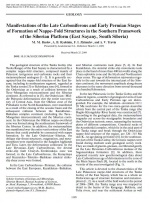Добрый день, Коллеги. Важное сообщение, просьба принять участие. Музей Ферсмана ищет помощь для реставрационных работ в помещении. Подробности по ссылке
Manifestations of the late carboniferous and early permian stages of formation of nappe-fold structures in the southern framework of the Siberian platform (East Sayany, South Siberia)
Проявления позднекаменноугольного и раннепермского этапов формирования покровно-складчатых структур в южном обрамлении Сибирской платформы (Восточные Саяны, Южная Сибирь)
The geological structure of the Tunka Goltsy (the Tunka Range) of the East Sayany is characterized by a complex nappe-fold structure, composed mainly of Paleozoic terrigenous and carbonate rocks and their metamorphosed analogues [1–3]. It is generally recognized that the nappe-fold structure of the East Sa-yany, including its southeastern segment, regarded as the Tunka terrain [3] or Ilchirskaya zone [4], formed in the Ordovician as a result of collision between the Tuva–Mongolian microcontinent and the Siberian continent. As referred to in [5], the Ordovician–Mid-dle Paleozoic deformations over the entire vast territory of Central Asia, from the Olkhon zone of the Pribaikalie to the North Kazakhstan, were manifested as a result of the closing of the oceanic basin and the subsequent collision between the Kazakhstan– Baikalian complex continent (including the Tuva– Mongolian microcontinent) and the Siberian continent. In the Ordovician the Olkhon nappe-overthrust zone was formed along the southeastern framework of the Siberian Craton. In addition, the metamorphism was manifested over the entire vast territory of the East Sayany that could probably be connected with nappe formation. In the Late Ordovician–Silurian, the oblique slip-thrust structures, magmatism, and meta-morphism were manifested in the Sangilen highlands and Tuva. Later, the deformations continued. In the Late Devonian–Early Carboniferous, the dextral strike-slip fault Charysh–Terektinskaya zone was formed; in the Late Carboniferous, the Kurayskaya and Kuznetsko–Teletsko–Bashkaus sinistral strike-slip shear zones were formed.
In the Late Carboniferous–Permian, the collision between the East European, Kazakhstan–Baikalian,and Siberian continents took place [5, 6]. In East Kazakhstan, the sinistral strike-slip movements took place in the band of more than 400 km width along the Chara ophiolite zone and the Irtysh and Northeastern shear zones. The age of deformation rejuvenates regularly to the east towards the internal part of the Siberian continent; the movement amplitude along shears decreases in the same direction from several thousand to a hundred kilometers.
In the late Palaeozoic in the Tunka Goltsy and the adjacent regions, a number of geological events of Late Carboniferous and Early Permian age are distinguished. For example, the rubidium–strontium 312 ± 20 Ma isochrone for the two-mica-garnet-staurolite schists from the central part of the Tunka range (the Bogdo-Khongoldoy River basin) was constructed [7]. According to the geological data, the metamorphism isogrades cut across the stratigraphic boundaries and the Ordovician tectonic zones, separating the tectonic plates of different compositions. Granitoid rocks of the Araosheiskii complex, which lie in the axial part of the Tunka range and break through the Ordovician nappe-fold structure of the region, are 320–315 Ma old (K–Ar age dating on biotite) [8]. In the southeastern part of the Tunka Goltsy, the tectonic nappes were found during medium scale geological survey work. They are made of granite-gneisses, overthrusted gently on the Late Devonian-Carboniferous molasse of the Sagansairskaya formation [2]. In addition, there appeared recently new geochronological data about Late Carboniferous age of deformations in the zone of the Main Sayan Fault [9], located to the north in the vicinity of the area investigated (Fig. 1). <...>




